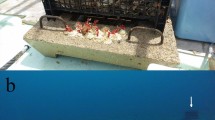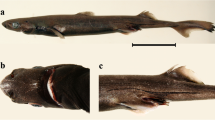Abstract
Rainfordia opercularis was described in 1923 from a single specimen taken in Edgecumbe Bay, Queensland, Australia. The species is rare in museum collections, and the larvae have not been described. In 1999, two settlement-stage larvae (20–21 mm in standard length) were collected in light traps set off Lizard Island, Great Barrier Reef, Queensland. The smaller of the two has one thin, flexible, extremely elongate dorsal-fin spine encased in a pigmented sheath. The larger specimen lacks an elongate dorsal-fin spine and exhibits caudal-fin pigment characteristic of adults. A combination of features in one or both of the settlement-stage larvae support the placement of Rainfordia in the epinepheline-serranid tribe Liopropomini: presence of an elongate, filamentous dorsal-fin spine serially associated with the first dorsal-fin pterygiophore; presence of a spine on the inner preopercular ridge; presence of dense pigment on the frontals; absence of an elongate spine at the angle of the preopercle; and absence of supraorbital spination.
Similar content being viewed by others
References
CC Baldwin GD Johnson (1993) ArticleTitlePhylogeny of the Epinephelinae (Teleostei: Serranidae) Bull Mar Sci 52 240–283
PH Greenwood DE Rosen SH Weitzman GS Myers (1966) ArticleTitlePhyletic studies of teleostean fishes, with a provisional classification of living forms Bull Am Mus Nat Hist 131 341–455
PC Heemstra JE Randall (1993) ArticleTitleFAO species catalog, vol 16. Groupers of the world (family Serranidae, subfamily Epinephelinae); an annotated and illustrated catalogue of the grouper, rockcod, hind, coral grouper and lyretail species known to date FAO Fish Synop 125 IssueID16 1–382
GD Johnson (1983) ArticleTitleNiphon spinosus: a primitive epinepheline serranid, with comments on the monophyly and intrarelationships of the Serranidae Copeia 1983 777–787 Occurrence Handle10.2307/1444346
AW Kendall SuffixJr (1976) ArticleTitlePredorsal and associated bones in serranid and grammistid fishes Bull Mar Sci 26 585–592
JM Leis BM Carson-Ewart (Eds) (2000) The larvae of Indo-Pacific coastal fishes. An identification guide to marine fish larvae Leiden Brill
AR McCulloch (1923) ArticleTitleFishes from Australia and Lord Howe Island Rec Aust Mus 14 113–125 Occurrence Handle10.3853/j.0067-1975.14.1923.833
JR Norman (1957) A draft synopsis of the orders, families and genera of recent fishes and fish-like vertebrates Photolithographed British Museum of Natural History London
JE Randall K Aida T Hibiya N Mitsuura H Kamiya Y Hashimoto (1971) ArticleTitleGrammistin, the skin toxin of soapfishes, and its significance in the classification of the Grammistidae Publ Seto Mar Biol Lab 19 157–190
JE Randall MM Smith K Aida (1980) Notes on the classification and distribution of the Indo-Pacific soapfish, Belonoperca chabanaudi (Perciformes: Grammistidae)Special publication no. 1 JLB Smith Institute of Ichthyology Grahamstown
JE Randall GR Allen RC Steene (1990) Fishes of the Great Barrier Reef and Coral Sea Crawford House Bathurst
LP Schultz (1966) ArticleTitlePseudorhegma diagramma, a new genus and species of grammistid fish, with a key to genera of the family and to the species of the subfamily Pseudogramminae Ichthyologica 37 1885–1894
IC Stobutzki DR Bellwood (1997) ArticleTitleSustained swimming abilities of the late pelagic stages of coral reef fishes Mar Ecol Prog Ser 149 35–41
DJ Woodland RJ Slack-Smith (1963) ArticleTitleFishes of Heron Island, Capricorn group, Great Barrier Reef Univ Queensland Pap 2 15–69
Author information
Authors and Affiliations
Corresponding author
Electronic Supplementary Material

FigS1.jpg
Settlement-stage larva of Rainfordia opercularis, AMS I. 39081-001, 21.4 mm SL, Lizard Island, Queensland. The semicircular band of pigment on the distal third of the caudal fin, which did not show well in the original black-and-white photograph, was enhanced using Adobe Photoshop. The natural pigment is best seen in a color photograph of this preserved specimen, which is available on Springer's server at springerlink.com
About this article
Cite this article
Baldwin, C., Leis, J. Rainfordia opercularis, a liopropomin serranid (Teleostei: Serranidae: Epinephelinae): corroborative evidence from settlement-stage larvae. Ichthyol Res 54, 193–197 (2007). https://doi.org/10.1007/s10228-006-0390-y
Received:
Revised:
Accepted:
Published:
Issue Date:
DOI: https://doi.org/10.1007/s10228-006-0390-y




